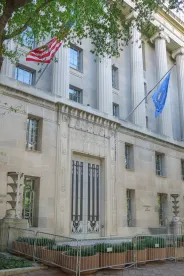For health care providers and other government contractors, perhaps no law causes more angst than the False Claims Act, 31 U.S.C. §§ 3729 et seq. (“FCA”). A Civil War-era statute initially designed to prevent fraud against the government, the FCA is often leveraged by whistleblowers (also known as “relators”) and their counsel who bring actions on behalf of the government in the hope of securing a statutorily mandated share of any recovery. These qui tam actions often can be paralyzing for health care entities, which, while committed to compliance, suddenly find themselves subject to false claims allegations that reflect a lack of understanding about the complex (and sometimes ambiguous) regulatory framework that they operate under.
Apart from the substantial costs associated with defending against qui tamallegations, the threatened financial exposure is heart-stopping: penalties under the FCA currently range from $10,957 to $21,916 per improper claim, plus three times the amount of damages sustained by the government (meaning, for example, if a health care provider is found liable for improperly submitting a level one evaluation and management (or “E/M”) code, the potential maximum exposure would be treble damages—i.e., three times the payment for the service—plus up to $21,916 in penalties per claim). For this reason, even when facing a meritless FCA suit, a defendant often settles to avoid the cost of litigation and the unpredictability of a jury. Indeed, very few FCA cases ever go to trial.
Until recently, health care providers facing the prospect of a qui tam suit have had little reason for optimism, particularly given the steady increase in cases being filed (674 new qui tam matters were filed in fiscal year 2017, and more than 70 percent of these related to federal health care programs) and the trend of relators continuing to pursue cases after the government declines to intervene. However, two recent U.S. Department of Justice (“DOJ”) internal policy memoranda issued this month suggest that, at least in some circumstances, the government may be reevaluating its approach in two key areas relating to FCA enforcement: (i) the dismissal of meritless qui tam actions when the government declines to intervene, and (ii) the prohibition of DOJ attorneys relying on a party’s noncompliance with agency guidance as presumptive or conclusive evidence that the party violated the law.
The Granston Memo
Recently, Michael D. Granston, the Director of the DOJ’s Civil Fraud Section, Commercial Litigation Branch, issued an internal memorandum to all attorneys in his branch and all Assistant U.S. Attorneys handling FCA cases (the “Granston Memo”). The Granston Memo, dated January 10, 2018, addresses “Factors for Evaluating Dismissal Pursuant to 31 U.S.C. 3730(c)(2)(A)” and potentially represents a significant shift in how DOJ treats meritless FCA cases.
DOJ has long had the authority via 31 U.S.C. § 3730(c)(2)(A) to dismiss FCA actions brought by whistleblowers. However, and as the Granston Memo acknowledges, DOJ has used this power sparingly. Instead, even in circumstances where a relator’s claims may have no basis in fact or law, DOJ has traditionally elected not to intervene and has permitted the relator to proceed, causing health care providers to spend considerable resources defending against a meritless claim. The Granston Memo suggests that simple declination may no longer be the status quo and provides a list of factors, not intended to be exhaustive, that DOJ attorneys should consider when evaluating whether the dismissal of a FCA claim is warranted in circumstances where DOJ declines to intervene. These factors focus on the following areas:
- curbing meritless qui tams,
- preventing parasitic or opportunistic qui tam actions,
- preventing interference with agency policies and programs,
- controlling litigation brought on behalf of the United States,
- safeguarding classified information and national security interests,
- preserving government resources, and
- addressing egregious procedural errors.
The Granston Memo instructs DOJ attorneys working on FCA cases to consider alternative grounds for dismissal other than 31 U.S.C. § 3730(c)(2)(A) and to consult affected federal agencies as to whether dismissal may be warranted.
The importance of this potential shift in DOJ policy should not be understated. While only time will tell how the Granston Memo will effect non-intervened qui tam matters, its issuance should come as a welcome sign to entities potentially subject to, or actively involved in, defending FCA cases, as well as to their defense counsel, who should view the memorandum as an opportunity to establish a dialogue—beyond pressing for declination—to pursue a wholesale dismissal of FCA allegations in a case that previously was thought likely futile.
The Brand Memo
While the Granston Memo represents a potentially significant change in DOJ’s approach to FCA litigation and role in non-intervened cases, on January 25, 2018, Associate Attorney General Rachel L. Brand issued a memorandum to the Heads of Civil Litigating Components / U.S. Attorneys and the Regulatory Reform Task Force, an internal working group within DOJ, titled “Limiting Use of Agency Guidance Documents in Affirmative Civil Enforcement Cases” (the “Brand Memo”).
The Brand Memo provides that, “effective immediately,” DOJ (i) “may not use its enforcement authority to effectively convert agency guidance documents into binding rules”[1] (emphasis added), and (ii) “may not use noncompliance with guidance documents as the basis for proving violations of application law . . . .” The Brand Memo goes on to state the following:
[DOJ] should not treat a party’s noncompliance with an agency guidance document as presumptively or conclusively establishing that the party violated the applicable statute or regulation. That a party fails to comply with agency guidance expanding upon statutory or regulatory requirements does not mean that the party violated those underlying legal requirements; agency guidance documents cannot create any additional legal obligations.
Critically, the Brand Memo explicitly provides that “this memorandum applies when [DOJ] is enforcing the False Claims Act, alleging that a party knowingly submitted a false claim for payment by falsely certifying compliance with material statutory or regulatory requirements.”
As with the Granston Memo, it is too soon to predict the impact that the Brand Memo will have on FCA litigation. But, at least on its face, the Brand Memo could be a game-changer. Medicare is the largest payer for health care services and the Centers for Medicare & Medicaid Services and its Medicare Administrative Contractors (“MACs”) have produced an enormous body of sub-regulatory guidance that governs health care providers. Because this informal guidance does not go through the rigorous review of the rule-making process mandated by the Administrative Procedure Act, it often can be ambiguous both in its application and its implementation. Such guidance also routinely results in different standards being applied to providers in different geographic regions depending upon which MAC has jurisdiction. The Brand Memo states that in circumstances where noncompliance with guidance is alleged, DOJ litigators are not to presume FCA liability or, perhaps more importantly, not to use such guidance to support or prove FCA violations.
Moreover, to the extent that the Brand Memo prohibits reliance on agency guidance documents, it may present an opportunity to argue that such prohibition must necessarily extend to similar documents prepared by government contractors that do not have agency status. DOJ attorneys frequently treat contractor guidance as conclusive in deciding whether there has been a violation of an underlying statute or regulation—even when guidance is released after the conduct at issue or by a government contractor in a different jurisdiction occurs. For example, reliance by DOJ attorneys upon statements in local coverage determinations when investigating and prosecuting FCA cases is commonplace. The Brand Memo may present an avenue for health care entities to argue that these determinations are fundamentally “guidance documents,” and, as such, DOJ should not reflexively and exclusively rely upon them when pursuing potential FCA liability.
At a minimum, the Brand Memo casts a cloud over practices that DOJ attorneys regularly employ when investigating, evaluating, and proving FCA allegations. It could have a major impact on the way in which the government handles FCA matters and evaluates both whether to intervene in a qui tam suit or bring an affirmative civil enforcement action.
Much remains to be seen as to the implications of the Granston and Brand Memos in practice. But for those individuals and entities participating in the health sector, as well as all other government contractors, these memoranda are reason for cautious optimism.
[1] The Brand Memo defines a “guidance document” as “any agency statement of general applicability and future effect, whether styled as ‘guidance’ or not, that is designed to advise parties outside of the federal Executive Branch about legal rights and obligations.” This definition largely mirrors the definition set forth by Attorney General Jeff Sessions in his November 16, 2017, memorandum setting forth a prohibition on improper guidance documents.





 />i
/>i
